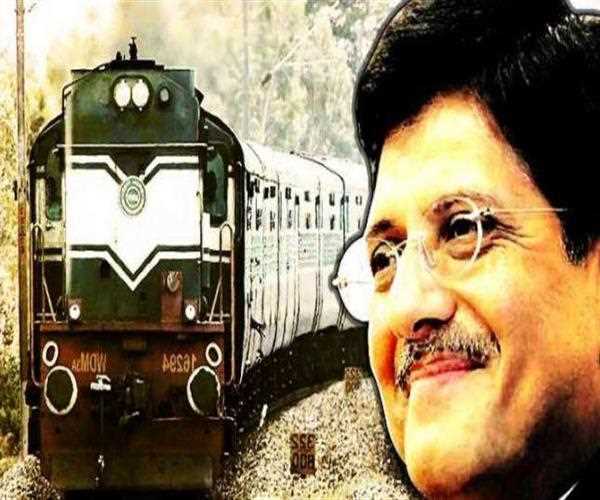
13-Aug-2020
Will Privatization Model Of Indian Railways Work Out ?
On 16 April 1853, the country's first passenger train ran between Mumbai to Thane. The train traveled 400 km carrying 14 passengers in 14 coaches. Since then, Indian Railways has undergone various operational, economic and technical improvements. Currently, Indian Railways has become the fourth largest network and lifeline of the country.
Indian Railways is also the most staffed department in the world. Railways began to liberalize the economy in the 1990s. For this, small steps were taken to privatize many services, such as catering service at stations, facilities to deliver food in trains, cleaning system. In 2006, the railways opened avenues for private operators to operate container trains. At the same time private investment was allowed in the construction of non-official railway lines.
State governments and the public sector gave approval to private investment for expansion of the rail network, so that rail services could be delivered to the last person. The privatization of passenger trains was initiated in 2018, when the Railways allowed IRCTC to run passenger trains.
The train running on the New Delhi-Lucknow rail route is known as Tejas. 2019-20 proved to be very important in the sense that the long-standing eight categories of re-structuring were done through the Indian Railway Management Service and permission to run private passenger trains through RFQ (Request for Qualification). Now 109 routes have been opened for private trains, out of which 151 trains of 16 coaches can be run.
It is believed that private train operations will start from April 2023. This time has been given to private operators to arrange for rolling stock and make a business plan. From the perspective of private investors, an estimated cost of Rs 30,000 crores would be required to run a private train. It will be mainly for design, production and procurement of rolling stock, passenger coach and locomotive (engine) procurement. It should also be noted that the train will have to run up to four thousand km at a speed of 160 kmph. The train should run 40 thousand km without any major maintenance. Obviously, the investment will also have to be made for this.
The RFQ also states that the bidder must develop a rolling stock maintenance facility at the train terminal. This will be a challenging task when multiple operators prefer a single route. This facility will require skilled manpower. Given the problem of land, this task can also be difficult. Although the RFQ rules that the railway will provide pit lines near the terminal, the private operator will have to take the machinery and manpower there, as there will be the maintenance of train sets and locomotives every 30 days.
The model of how this will work between heavy machines and permanent infrastructure will also be worth looking at. Look at the example of IRCTC. Private caterers were asked to make separate base kitchens and provide food on a train like Shatabdi / Rajdhani, but what happened?
Most caterers started preparing food according to the shift, which was not good according to the purity of the food. This was a lesson for the IRCTC, so he asked the third party to make megabase kitchens and just give them food on the train. Therefore, an inspection of rolling stock maintenance work conducted by a third party will also be required. It will also be a challenge to keep stock of different types of train sets.
Now come to the commercial aspect. According to the RFQ, the private operator will have to bid on the basis of total revenue, including ticket rate, premium seats, Wi-Fi, readable content, entertainment, catering, etc.
Railways can also collect TAC (track access charge) from these private operators, which will include running trains on the route, station usage, availability of crew, and guards. Apart from this, the operator will also have to pay the electricity usage charge to the railways, which will be charged by the railways on an electrified route. TAC will be the key to the success of this experiment for railways.
Lave will have to plan for the right TAC, only then can he recover his cost. It will also be difficult for the railways to estimate the exact cost of running the train. Private trains will get subsidy on freight, so that passenger fares can be kept low. If we look at the model of fixing TAC around the world, then the railways will have to make a transparent plan for it. The privatization of British Railways would also have to be seen, which proved to be a failure.
READ HERE MORE : Importance Of Women Participation In Indian Armed Forces
The commencement of the private train in April 2023 is also a challenge. Interested companies have been asked to submit their reply by 8 September 2020. The Railway Ministry will shortlist the company within 60 days. Those who will be successful in making space, they will have only 24 months left for complete preparation. See the example of a container train started in 2006, in which 16 private operators were licensed, but many operators have not yet started the first phase of the service, many have stopped operations due to heavy operational losses.
If the railway has to make the private train model a success, it will have to work under a business plan with transparent policies. Such a situation has to be created for both the investor and the operator so that they can move their project forward.

Content Writer
I am a Website Developer. And Write Articles on health, general, SEO, gaming, real estate, movies, songs and other reviews. and i also work on SEO search engine optomization.
Join Our Newsletter
Subscribe to our newsletter to receive emails about new views posts, releases and updates.
Copyright 2010 - 2025 MindStick Software Pvt. Ltd. All Rights Reserved Privacy Policy | Terms & Conditions | Cookie Policy